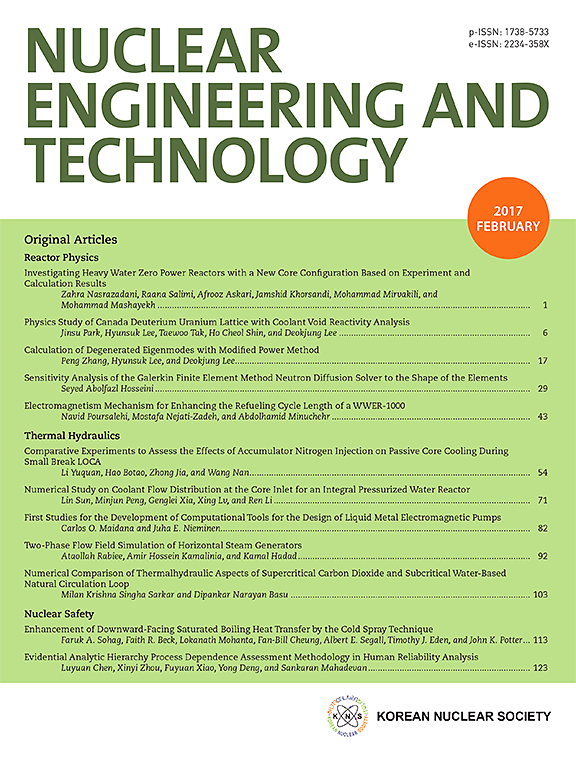考虑老化效应的超压条件下核反应堆安全壳密封性评估
IF 2.6
3区 工程技术
Q1 NUCLEAR SCIENCE & TECHNOLOGY
引用次数: 0
摘要
本文评估了超压条件下老化对安全壳密封性的影响。建立了安全壳整体模型和安全壳三个主要渗透区域的详细子模型。阐明了安全壳的主要老化形式和机理,并提供了相应的模拟方案。通过数值模拟,从确定性角度讨论了不同老化形式对安全壳失效压力的影响。最后,评估了不同老化条件下安全壳的脆性和功能失效概率。当考虑到 60 年的混凝土退化和预应力损失时,设备舱口、人员气闸和管道贯穿的承压能力降低了约 5%。如果进一步考虑钢衬里的腐蚀,当腐蚀程度达到 30% 时,这些区域的承压能力将分别降低 24.37%、25.52% 和 22.83%。在本研究范围内,钢衬里腐蚀对安全壳泄漏风险的影响最为明显,而混凝土退化的影响则微乎其微。如果钢衬里腐蚀同时发生在三个渗透区域,当腐蚀度达到 30% 时,整个安全壳将无法达到概率性能目标。本文章由计算机程序翻译,如有差异,请以英文原文为准。
Assessment of leak-tightness for nuclear reactor containment under overpressure conditions considering aging effects
This paper assesses the aging effects on the leak-tightness of containment under overpressure conditions. A global containment model and the detailed sub-models for the three main penetration regions in the containment are established. The main aging forms and mechanisms of containment are clarified, and corresponding simulation schemes are provided. Through numerical simulation, the impacts of different aging forms on the failure pressure of containment are discussed from a deterministic perspective. Finally, the fragility and functional failure probability of containment under different aging conditions are evaluated. When 60 years of concrete degradation and prestress loss are considered, the pressure capacities of equipment hatch, personnel airlock, and pipe penetration are reduced by approximately 5 %. Upon further considering steel liner corrosion, when the corrosion degree reaches 30 %, the pressure capacities of these regions are reduced by 24.37 %, 25.52 %, and 22.83 %, respectively. Within the scope of this study, the impact of steel liner corrosion on the risk of containment leakage is the most pronounced, whereas the impact of concrete degradation is minimal. If steel liner corrosion occurs simultaneously in three penetration regions, the whole containment will fail to meet the probabilistic performance goal when the corrosion degree reaches 30 %.
求助全文
通过发布文献求助,成功后即可免费获取论文全文。
去求助
来源期刊

Nuclear Engineering and Technology
工程技术-核科学技术
CiteScore
4.80
自引率
7.40%
发文量
431
审稿时长
3.5 months
期刊介绍:
Nuclear Engineering and Technology (NET), an international journal of the Korean Nuclear Society (KNS), publishes peer-reviewed papers on original research, ideas and developments in all areas of the field of nuclear science and technology. NET bimonthly publishes original articles, reviews, and technical notes. The journal is listed in the Science Citation Index Expanded (SCIE) of Thomson Reuters.
NET covers all fields for peaceful utilization of nuclear energy and radiation as follows:
1) Reactor Physics
2) Thermal Hydraulics
3) Nuclear Safety
4) Nuclear I&C
5) Nuclear Physics, Fusion, and Laser Technology
6) Nuclear Fuel Cycle and Radioactive Waste Management
7) Nuclear Fuel and Reactor Materials
8) Radiation Application
9) Radiation Protection
10) Nuclear Structural Analysis and Plant Management & Maintenance
11) Nuclear Policy, Economics, and Human Resource Development
 求助内容:
求助内容: 应助结果提醒方式:
应助结果提醒方式:


